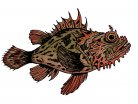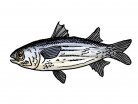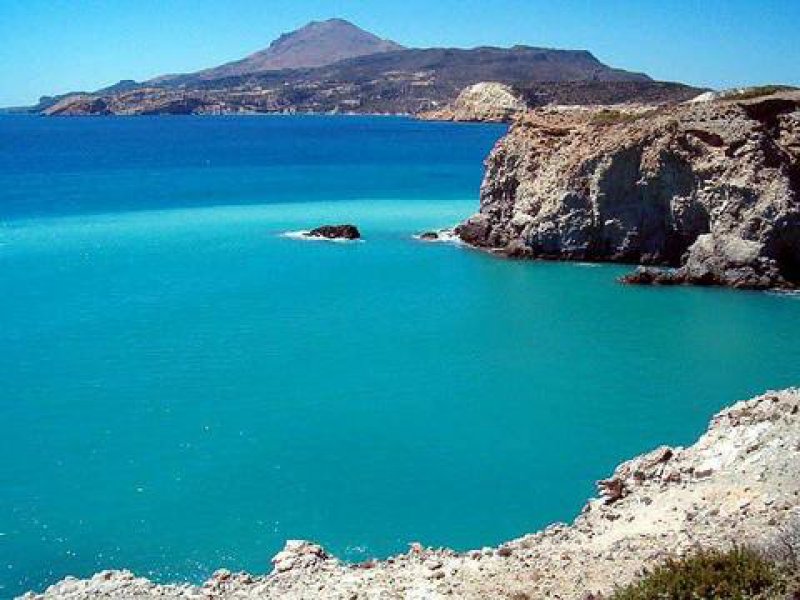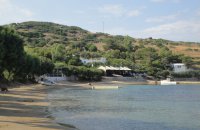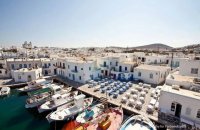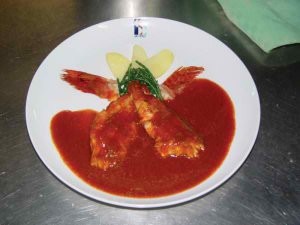1. Hydra, Saronic Gulf
Why? Wealthy Athenians head to charming Hydra for relaxing weekend breaks: cars, motorbikes and high-rise buildings are banned on the island. The architecture is unique for the region, with many art galleries and museums in 18th-century mansions.
What to do Hydra port is the only town; the interior is largely uninhabited. Narrow streets lead from the pretty harbor to the cathedral, museum, monasteries, churches and galleries. Donkeys and water taxis transport tourists to small villages and swimming spots along the coast (most beaches are rocky or pebbly).
Where to eat and stay: Plenty of restaurants in Hydra serve local seafood, or try the little village of Kamini, a 40-minute walk around the headland, for traditional tavernas.
How to get there: There are ferries and catamarans from Piraeus, many of which continue to Spetses, another upmarket island.
2. Milos, Cyclades
Why? This volcanic island has a spectacular lunar landscape of red, brown and white rocks, and around 70 equally colorful beaches: white, gold, red and grey. There are pretty whitewashed fishing villages and more rugged mountain settlements.
What to do Visit the ancient theatre, catacombs and windmills in Tripiti, where the Venus de Milo statue was found; take a caïque (fishing boat) tour of the island's coves; go to Plaka, the former capital and a great spot to watch the sunset; take in as many beaches as time allows, such as eerie, moonlike Sarakiniko.
Where to eat and stay Adamas, the main port, has a good selection of restaurants
How to get there: Two flights a day from Athens, ferries from Piraeus
3. Alonnisos, Sporades
Why? This is not the Greek island of travel posters. Instead of barren hillsides and sugar-cube villages, you get fertile slopes, dense pine forests and stone-roofed cottages. Alonissos is much the quietest of the Sporades group, in the northern Aegean, that includes Skopelos and Skiathos.
What to do Chrisi Milia beach is lovely for sunbathing: golden sand, turquoise water, trees for shade, rock pools and a taverna. Hire a moped and check out the island's many other coves, bays and (pebbly) beaches. Spot dolphins and seals on a boat trip from Patitiri harbour into Greece's first National Marine Park .
Where to eat and stay In Patitiri you can sit on the harbour and watch as the fish you will soon be eating is landed. For a treat, Taverna Astrofegia (+30 242 406 5182) in the old capital, Chora, has slightly more sophisticated dishes. Liadromia Hotel (doubles from £60, +30 242 406 5521, liadromia.gr) a five-minute walk up the hill from the port, has 14 double rooms with great views from their little balconies, and a handful of self-catering studios.
How to get there: Flights to Skiathos, and Alonissos is 90 minutes away by ferry, via Skopelos.
4. Kastelorizo, Dodecanese
Why? Tiny Kastelorizo is Greece's smallest permanently inhabited island and the furthest from Athens. It has pretty Anatolian-style houses (the island is 2km off the coast of Turkey), hilltop castles and very clear seas.
What to do Take a boat to the Blue Grotto, a dazzling sea cave underlit by refracted sunlight – it is much bigger than the more famous grotto in Capri, Italy. Carry on to St George, a tiny rock-isle, to snorkel and sunbathe in seclusion. Back on Kastellorizo, hike up to the monastery and castle above the harbour for views across to Kas in Turkey – or even take a day trip there.
Where to eat and stay: Fresh seafood at one of the many tavernas flanking the harbour is the way to go.
How to get there: Flights, hydrofoils and ferries from Rhodes, ferries from Kas.
5.Gavdos, near Crete
Why? The most southerly Greek island, tiny Gavdos has fewer than 45 permanent residents, smells of sea juniper and wild thyme – and has a laid-back 1960s spirit. (Read Ben Mallalieu's excellent piece on the island)
What to do Simply walk round the island enjoying the sand dunes, the wild flowers, and the sense of peace and wildness. The island offers particularly striking golden beaches at Potamos and Agios Ioannis
Where to eat and stay: Korfos, Kastri and Sarakiniko offer the most popular tavernas. There are no hotels: rooms can be rented through gavdos-online.com. Or bring a tent: visitors are welcome to camp on the island
How to get there: From April to the end of August there are ferries from south-west Crete, leaving from Paleochora and Chora Sfakion – but they don't operate if the wind is blowing in the wrong direction.
6. Ithaca, Ionian
Why? Ithaca is just a 45-inute ferry ride from Kefalonia, but is far less developed. In the lush green valleys and rugged hills, hiking trails lead walkers to hidden ruins and stunning sea views.
What to do Trek along the cobbled footpaths or cycle around the dirt roads of the interior. Brush up on your Greek myths at the archaeological sites (Ithaca is thought to be the homeland of Homer's Odysseus). Visit Exogi and Anogi, two crumbling villages on twin capes in the north of the island with views across the archipelago.
Where to eat and stay: The seafood is great in Frikes and Kioni, two harbour villages with a high concentration of tavernas.
How to get there: Flights to Kefalonia and ferries on to Ithaca, or ferries from Patras or Astakos.
7.Syros, Cyclades
Why? Syros is a bustling, working island little-visited by foreign tourists – although Athenians have caught on to its charms. It has a fascinating capital, Ermoupolis (also the capital of the Cyclades), a 13th-century Venetian-built town called Ano Syros, and lovely beaches in the north.
What to do Explore grand, colourful Ermoupolis and people-watch in the main square, then head up the hill to Ano Syros. Its narrow lanes and marble steps lead to St George's church, from where there are panoramic views of six neighbouring islands. Take a speedboat to Lia and Grammata beaches, which are fringed with palm trees and backed by rocky hills.
Where to eat and stay Ermoupolis is great for restaurants with live bouzouki music, especially at weekends.
How to get there: There are flights, boats and hydrofoils from Athens.
8.Ikaria, eastern Aegean
Why? Verdant Ikaria's mountainous interior is covered by bush and forest, and it has more rivers, waterfalls and gorges than the average Greek island. The island's inhabitants are said to live long and go their own way – often sleeping during the day and doing business at night, for example.
What to do Explore the forests and ruins; visit the thermal springs on Thermes coast; go to a barely touched beach such as Agios Giorgis in the far north, which requires a drive down an unpaved road and a 20-minute hike; attend a raucous festival and drink the strong local red wine.
Where to eat and stay: Platanos Taverna in Agios Dimitrios serves organic, homegrown food. Traditional stone houses are available to rent at the Ikarian Winery in Piyi, an agrotourism centre that also offers wine and cooking courses.
How to get there: There are flights from Athens and ferries from Pireaus.
9.Paxos, Ionian
Why? Small, picturesque Paxos is about 15km south of Corfu. Its coast is dotted with quiet fishing villages, its sleepy interior cloaked with olive groves divided by crumbling drystone walls.
What to do Watch the fishing boats at the port of Gaios; amble across the island on donkey tracks; head to the sandy beach of Mongonisi in the south.
Where to eat and stay: Loggos, Gaios and Lakka offer the best choice of tavernas and bars.
How to get there: Ferries run from Corfu Town and Lefkimi in Corfu, and from Igoumenitsa on the mainland.
10.Tilos, Dodecanese
Why? Tilos specializes in eco-tourism and is a protected environment, with an abundance of birds and other wildlife. The valleys are full of wildflowers, pine, oak and almond trees.
What to do The countryside is peppered with Byzantine chapels and Crusader castles, plus there's a monastery and an abandoned village. In one cave the remains of a previously unknown species of dwarf elephant were found: there's an exhibition about the discovery. Of the island's 19 beaches, many can only be reached on foot or by boat.
Where to eat and stay The main settlements of Livadio and Megalo Chorio have the most tavernas.
How to get there: A catamaran from Rhodes Town takes 80 minutes.











































